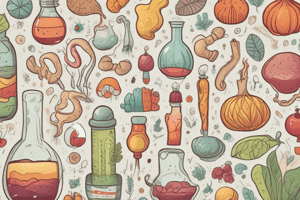Podcast
Questions and Answers
Carbohydrates are composed of carbon, hydrogen and ______ in a specific proportion.
Carbohydrates are composed of carbon, hydrogen and ______ in a specific proportion.
oxygen
The formula for carbohydrates is expressed as (CH2O)______.
The formula for carbohydrates is expressed as (CH2O)______.
n
Certain carbohydrates can contain other elements such as ______ and nitrogen.
Certain carbohydrates can contain other elements such as ______ and nitrogen.
sulphur
CHO are defined as polyhydroxy ______ and ketones.
CHO are defined as polyhydroxy ______ and ketones.
Carbohydrates are divided into simple sugars (Saccharides) and ______ or polysaccharides.
Carbohydrates are divided into simple sugars (Saccharides) and ______ or polysaccharides.
Monosaccharides are those sugars which on hydrolysis yield no ______ sugars.
Monosaccharides are those sugars which on hydrolysis yield no ______ sugars.
The general formula for monosaccharides is ______.
The general formula for monosaccharides is ______.
A chain form monosaccharide with a carbonyl group on an end carbon is referred to as an ______.
A chain form monosaccharide with a carbonyl group on an end carbon is referred to as an ______.
Bioses contain two carbon atoms and are rarely found in nature. The only known compound is ______.
Bioses contain two carbon atoms and are rarely found in nature. The only known compound is ______.
Triose contains ______ carbon atoms and represents the simplest form of monosaccharide sugar found in nature.
Triose contains ______ carbon atoms and represents the simplest form of monosaccharide sugar found in nature.
Tetrose contains ______ carbon atoms, e.g., erythrose.
Tetrose contains ______ carbon atoms, e.g., erythrose.
Pentose are very common in plants and are the product of hydrolysis of polysaccharides such as ______.
Pentose are very common in plants and are the product of hydrolysis of polysaccharides such as ______.
Hexoses are monosaccharides containing ______ carbon atoms.
Hexoses are monosaccharides containing ______ carbon atoms.
Heptose contains ______ carbon atoms and plays a key role in photosynthesis of plants.
Heptose contains ______ carbon atoms and plays a key role in photosynthesis of plants.
Oligosaccharides consist of short chain monosaccharide units joined by characteristic linkages called ______ bonds.
Oligosaccharides consist of short chain monosaccharide units joined by characteristic linkages called ______ bonds.
Disaccharides on hydrolysis yield ______ molecules of monosaccharide.
Disaccharides on hydrolysis yield ______ molecules of monosaccharide.
Sucrose yields
plus
plus
Sucrose yields
plus
plus
Maltose yields
glucose plus glucose.
Maltose yields
glucose plus glucose.
Lactose yields
plus Galactose.
Lactose yields
plus Galactose.
Raffinose yields Glucose plus Fructose plus
.
Raffinose yields Glucose plus Fructose plus
.
Gentinose yields Glucose plus Glucose plus
.
Gentinose yields Glucose plus Glucose plus
.
Tetrasaccharides can yield
molecules of monosaccharides on hydrolysis.
Tetrasaccharides can yield
molecules of monosaccharides on hydrolysis.
Polysaccharides are formed by condensation and the elimination of
.
Polysaccharides are formed by condensation and the elimination of
.
Homopolysaccharides give only one type of
unit on hydrolysis.
Homopolysaccharides give only one type of
unit on hydrolysis.
Flashcards are hidden until you start studying
Study Notes
Overview of Carbohydrates
- Composed of carbon, hydrogen, and oxygen, typically in a ratio similar to water (CH₂O)n.
- Include polyhydroxy aldehydes and ketones, derived from the hydrolysis of more complex structures.
- Key in pharmacognosy, forming glycosides and secondary metabolites during plant photosynthesis.
Classification of Carbohydrates
- Divided into simple sugars (saccharides) and complex carbohydrates (polysaccharides).
- Simple sugars categorized as mono, di, tri, tetra, etc., based on carbon count.
Monosaccharides
- Simplest form of carbohydrates, with the formula CₙH₂ₙOₙ.
- Subdivided into:
- Bioses: 2 carbon atoms (e.g., glycoaldehyde, C₂H₄O₂).
- Trioses: 3 carbon atoms (e.g., glyceraldehyde).
- Tetroses: 4 carbon atoms (e.g., erythrose).
- Pentoses: 5 carbon atoms, common in plants (e.g., ribose, arabinose, xylose).
- Hexoses: 6 carbon atoms, abundant in plants; include aldoses (glucose, mannose, galactose) and ketoses (fructose).
- Heptoses: 7 carbon atoms, rare, involved in photosynthesis and glucose metabolism (e.g., glucoheptalose).
Oligosaccharides
- Composed of short chains of monosaccharides connected by glycosidic bonds.
- Naming convention ends in “--ose”; typically not existing freely.
Disaccharides
- Yield two monosaccharide molecules upon hydrolysis.
- Examples include:
- Sucrose: glucose + fructose.
- Maltose: glucose + glucose.
- Lactose: glucose + galactose.
Trisaccharides
- Composed of three monosaccharide units upon hydrolysis.
- Examples include:
- Raffinose: glucose + fructose + galactose (found in sugarcane).
- Gentianose: glucose + glucose + fructose (found in gentian root).
Tetrasaccharides
- Yield four monosaccharide units upon hydrolysis.
- Example: Stachyose (1 glucose, 2 galactose, and 1 fructose).
Polysaccharides
- Complex carbohydrates yielding an indefinite number of monosaccharides.
- Formed through condensation reactions, eliminating water.
- Examples include:
- Cellulose: composed of glucose units with β-1,4 glycosidic linkages.
- Starch: glucose linked by α-1,4 and α-1,6 bonds.
- Commonly insoluable in water and non-sweet; often form colloidal suspensions.
Classification of Polysaccharides
- Based on hydrolysis products:
- Homopolysaccharides: yield one type of monosaccharide (e.g., starch, cellulose, glycogen).
- Heteropolysaccharides: yield multiple types (e.g., hemicellulose, pectin).
Studying That Suits You
Use AI to generate personalized quizzes and flashcards to suit your learning preferences.




